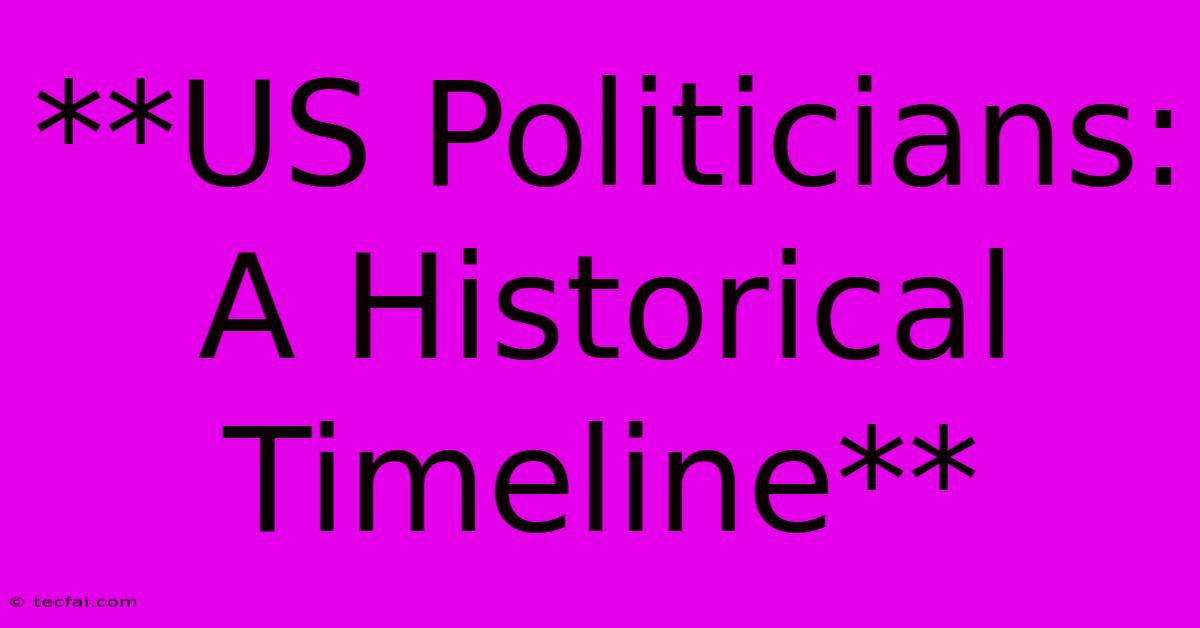**US Politicians: A Historical Timeline**

Discover more detailed and exciting information on our website. Click the link below to start your adventure: Visit Best Website tecfai.com. Don't miss out!
Table of Contents
US Politicians: A Historical Timeline of Power and Influence
From the founding fathers to the modern era, American politics has been shaped by a diverse cast of influential figures. This historical timeline explores key moments and the individuals who left their mark on the nation's political landscape.
The Birth of a Nation: 1776-1865
1776: The Declaration of Independence is signed, marking the birth of the United States. Thomas Jefferson, the principal author, becomes a pivotal figure in shaping the country's ideology.
1787: The US Constitution is ratified, establishing a federal republic. James Madison, known as the "Father of the Constitution," plays a key role in its creation.
1789: George Washington is inaugurated as the first President, setting the stage for the new nation's political system.
1801-1809: Thomas Jefferson becomes the third President, furthering the ideals of democracy and limited government.
1861-1865: The Civil War erupts, testing the nation's unity and bringing Abraham Lincoln to the forefront. His leadership during this tumultuous period ensures the preservation of the Union and the abolition of slavery.
The Rise of Industrialism and Reform: 1865-1914
1865: The Civil War ends, ushering in a period of rapid industrialization and westward expansion.
1881-1885: Chester A. Arthur becomes President, tackling issues of civil rights and labor reform.
1901-1909: Theodore Roosevelt emerges as a champion of progressive reform, advocating for conservation, trust-busting, and consumer protection.
1913: The 17th Amendment is ratified, establishing the direct election of Senators, increasing public participation in government.
The World Wars and the New Deal: 1914-1945
1917-1918: The United States enters World War I, with Woodrow Wilson advocating for international cooperation and peace.
1929: The Great Depression begins, plunging the nation into economic hardship.
1933-1945: Franklin D. Roosevelt leads the country through the Depression and World War II, implementing the New Deal to stimulate economic recovery and establish social safety nets.
1941-1945: The United States participates in World War II, emerging as a global superpower.
The Cold War and the Civil Rights Movement: 1945-1991
1945-1991: The Cold War intensifies, with the United States and the Soviet Union engaging in a global struggle for dominance.
1945-1953: Harry S. Truman leads the nation in the postwar era, implementing the Marshall Plan to rebuild Europe and establishing the United Nations.
1961-1963: John F. Kennedy becomes President, inspiring a generation with his vision of "a New Frontier."
1963-1969: Lyndon B. Johnson continues Kennedy's legacy, enacting landmark legislation for civil rights and social programs.
1968-1974: Richard Nixon wins the presidency, but his legacy is marred by the Watergate scandal, leading to his resignation.
1974-1977: Gerald Ford becomes the first unelected President, facing economic challenges and the lingering effects of Watergate.
1977-1981: Jimmy Carter focuses on energy policy, human rights, and international diplomacy.
1981-1989: Ronald Reagan leads a conservative resurgence, advocating for tax cuts, deregulation, and a strong military.
1989-1993: George H.W. Bush continues Reagan's policies, leading the nation through the end of the Cold War.
The New Millennium and Beyond: 1991-Present
1993-2001: Bill Clinton focuses on economic growth and social programs, navigating the challenges of globalization.
2001-2009: George W. Bush leads the nation through the 9/11 attacks and the wars in Afghanistan and Iraq.
2009-2017: Barack Obama becomes the first African American President, advocating for healthcare reform, economic recovery, and climate change action.
2017-2021: Donald Trump challenges the political establishment with his populist rhetoric and nationalist policies.
2021-present: Joe Biden takes office, facing the ongoing COVID-19 pandemic, economic challenges, and political polarization.
This historical timeline only highlights a few of the many influential US politicians throughout history. From revolutionaries to reformers, presidents to senators, each individual has contributed to the evolution of American politics, shaping the nation's identity and direction. Understanding this diverse and dynamic past is essential for navigating the challenges and opportunities of the future.

Thank you for visiting our website wich cover about **US Politicians: A Historical Timeline**. We hope the information provided has been useful to you. Feel free to contact us if you have any questions or need further assistance. See you next time and dont miss to bookmark.
Featured Posts
-
Man Utd 1 1 Chelsea Epl Match Recap
Nov 04, 2024
-
Herby Moreau Animator Passes Away In Location
Nov 04, 2024
-
Whakaari Owners Judge Weighs In On Conviction
Nov 04, 2024
-
Stage Collapse Injures Rocker At Aussie Concert
Nov 04, 2024
-
Quincy Jones Musiekmeester En Legende
Nov 04, 2024
